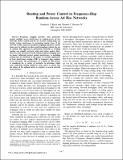Routing and power control in frequency-hop random-access ad hoc networks
Author(s)
Block, Frederick J., IV; Royster, Thomas C., IV
DownloadBlock-2009-Routing and power control in frequency-hop random-access ad hoc networks.pdf (771.7Kb)
PUBLISHER_POLICY
Publisher Policy
Article is made available in accordance with the publisher's policy and may be subject to US copyright law. Please refer to the publisher's site for terms of use.
Terms of use
Metadata
Show full item recordAbstract
Frequency hopping provides some protection against multiple access interference in random-access ad hoc networks. Power control and the use of short routing hops can further reduce interference by promoting spatial reuse. If the network is fully connected, frequency hopping and power control alone may be sufficient to allow good throughput without the use of routing. This approach is particularly desirable as avoiding routing can simplify network setup and reduce packet delay. However, if the network is heavily loaded, frequency hopping may no longer sufficiently protect against interference, so including routing may be beneficial. In this paper, we consider application of least interference routing (LIR) to frequency hop random-access networks. The performance of a family of LIR metrics is considered for a variety of networks to determine which cases multi-hop routing should be used, and it is shown that the choice of the optimal metric is sensitive to several network characteristics.
Date issued
2010-01Department
Lincoln LaboratoryJournal
MILCOM 2009
Publisher
Institute of Electrical and Electronics Engineers
Citation
Block, F.J., and T.C. Royster. “Routing and power control in frequency-hop random-access ad hoc networks.” Military Communications Conference, 2009. MILCOM 2009. IEEE. 2009. 1-7. © 2009 IEEE
Version: Final published version
Other identifiers
INSPEC Accession Number: 11085622
ISBN
978-1-4244-5238-5